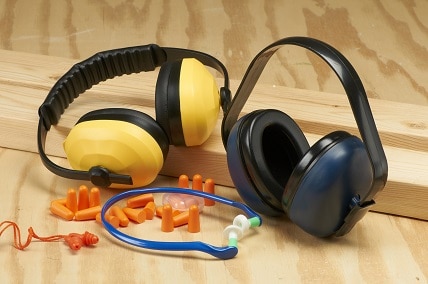KEY TAKEAWAY: Hearing protection is necessary to prevent health risks from noise exposure. Here are the pros and cons of custom earplugs for occupational noise exposure.
Jump Ahead
Effects of Noise Exposure
Researchers have long associated hearing loss with long-term exposure to hazardous noise or short-term exposure to extreme levels of noise. Exposure to dangerous noise happens far more often than many of us realize. In fact, researchers found that 43% of workers in one study had experienced long-term exposure to hazardous noise levels in the workplace. The researchers defined hazardous noise levels as being unable to speak at normal levels with someone who is at arm’s length. Surprisingly, just 36% of people who worked in these noisy environments were required to wear hearing protection.

Exposure to high noise levels can lead to permanent noise-induced hearing loss, which cannot be reversed with surgery or hearing aids.
Once your hearing is damaged, it cannot be fixed. However, good hearing protection can help prevent hearing loss and damage along with many other hearing-related conditions such as tinnitus. The use of appropriate hearing protection devices designed to protect your hearing can essentially eliminate all of these conditions related to occupational noise exposure.
Every provincial labour department sets its own standards. Still, most jurisdictions prevent workers from being exposed to noises that exceed a time-weighted average exposure limit of 85 dBA that is measured over an eight-hour workday. They also mandate hearing protection for workers who must be exposed to high levels of noise.
There are several options for hearing protection, including earmuffs and both custom and disposable earplugs. Earplugs are a popular choice both for their comfort and ease of use. However, while all earplugs can help protect against noise, disposable earplugs can be less effective than custom earplugs. For employers trying to determine what the right fit is for their team, here are the pros and cons of custom moulded hearing protection.
Pros
Molded for Exact Fit
A trained impression taker and laboratory technician will create an exact mold of all portions of your ear, including the canal, concha and helix. The earplugs are crafted for a precise fit to your specific ear canal and ear. An exact fit means the earplugs will be more comfortable and still block out excessive noise. It also ensures they will not put undue pressure on your ear canal or stick out too far and potentially catch on other headgear.
Comfort
Unlike earmuffs, workers can wear custom earplugs under helmets, with earrings, and with glasses without interfering with fit or effectiveness. The fit and the materials they are made from make them more comfortable for long-term wear in hot or humid work areas. They can also be more convenient for use in small or confined spaces than other hearing protection alternatives.
Easy to Store
Earplugs are small and easily stored in a locker or transported to and from work, making them more convenient for your employees to have on hand at all times.
Reusable
Since custom earplugs are designed for repeated wear, they do not cause the kind of waste and long-term environmental damage that disposable earplugs do. This can be a huge bonus if your company tries to implement environmentally-friendly measures whenever possible.
Long-Lasting
Custom earplugs can last for many years, often five or more if they are well cared for. Thus, while they may be more expensive initially than their disposable counterparts, the cost per use will likely be much lower over time.
Individualized
Every ear canal is different. Because custom earplugs fit your ear canal exactly, they won’t dislodge, fall out or cause you discomfort. Custom earplugs are also excellent for tiny ear canals or oddly shaped canals resulting from an injury or a congenital disability. They can help ensure all members of your team are equally protected.
Customized Noise Protection
Custom earplugs can be made with special filters to block out specific levels and types of noise. This is an advantage over disposable earplugs, which muffle all noise. This customization is essential for workers who need to hear certain things while still blocking out dangerous noise levels.
Cons
Occasional Discomfort
Earplugs can cause general discomfort for some people, primarily if used for long periods of time, as they must be held in the ear canal. However, custom-fitted earplugs do essentially eliminate the feeling of compression some people associate with disposable earplugs.
Not Suitable for High Levels of Noise
Even custom earplugs are not recommended for extremely high levels of noise such as levels above 105 dBA. They can, however, be combined with earmuffs for additional protection when noise reaches higher levels, offering flexibility to your team depending on what tasks they have on their plate and what the associated noise levels are.
Need to be Fitted
Custom earplugs require an earmold impression of the ear canal to ensure proper fit. Some people find this process somewhat uncomfortable. You must also set aside time for your employees to get this impression done before they are able to work.
Maintenance
Unlike their disposable counterparts, which you can toss in the trash once you are finished with them, custom earplugs require simple but regular cleaning with mild soap and water. You can risk introducing dirt or infection if you don’t properly care for them. You may need to build in some maintenance and care training for your employees. This is important for the longevity of their custom earplugs, as well as their own health.
Initial Costs
There is a higher upfront cost for custom earplugs compared to disposable earplugs. However, disposable earplugs are generally only cheaper if used sporadically rather than daily.
Break-in Time
Custom earplugs may take some time to break in properly. This process can take up to a week with lubricant application to ease application until they can be easily inserted.
In Conclusion
If your employees are exposed to noise during their day, hearing protection is absolutely essential. While you want to ensure they are equipped with the appropriate hearing protection, prevention is also key. SureHire’s audiometric testing services can help you detect noise-induced hearing loss before it becomes a problem.
You May Also Be Interested In…
- Do You Have Reasonable Suspicion?
 Employers cannot initiate reasonable suspicion testing without first going through the 5-step process. Reasonable suspicion training provides critical information about how to initiate reasonable suspicion testing, including the 5-step process and other tools that employers can use to help manage the misuse of alcohol and drugs in the workplace.
Employers cannot initiate reasonable suspicion testing without first going through the 5-step process. Reasonable suspicion training provides critical information about how to initiate reasonable suspicion testing, including the 5-step process and other tools that employers can use to help manage the misuse of alcohol and drugs in the workplace. - An Employer’s Guide: What You and Your Employees Need to Know About DOT Drug & Alcohol Testing
 When implementing or maintaining DOT Drug & Alcohol testing, there are key areas that employers should consider.
When implementing or maintaining DOT Drug & Alcohol testing, there are key areas that employers should consider. - SureHire Occupational Testing Acquires COHR Health: A Positive Step Towards Safe, Healthy, Productive Workforces and Communities
 We are thrilled to announce that today, May 6, 2024, SureHire Occupational Testing has officially acquired COHR Health, a well-known leader in occupational health services. Read on…
We are thrilled to announce that today, May 6, 2024, SureHire Occupational Testing has officially acquired COHR Health, a well-known leader in occupational health services. Read on… - Occupational Testing Use Case – Mining
 In this case study, we will explore how mining companies can use various types of occupational tests to reduce Total Recordable Incident Rates (TRIR) long term.
In this case study, we will explore how mining companies can use various types of occupational tests to reduce Total Recordable Incident Rates (TRIR) long term. - 9 Strategies to Keep Workers Cool on Drilling Sites During Hot Summer Months
 This article delves into strategies to keep workers cool and safe on drilling sites during the hot summer months.
This article delves into strategies to keep workers cool and safe on drilling sites during the hot summer months. - Hearing Conservation Basics: How to Manage Occupational Noise
 Learn how to proactively mitigate occupational noise risks and help prevent NIHL among workers.
Learn how to proactively mitigate occupational noise risks and help prevent NIHL among workers.

